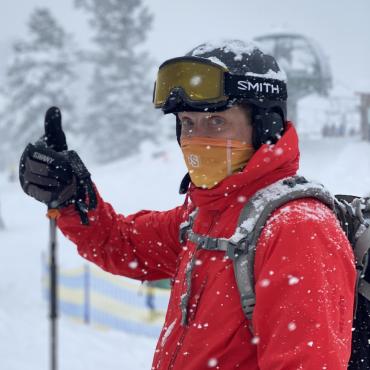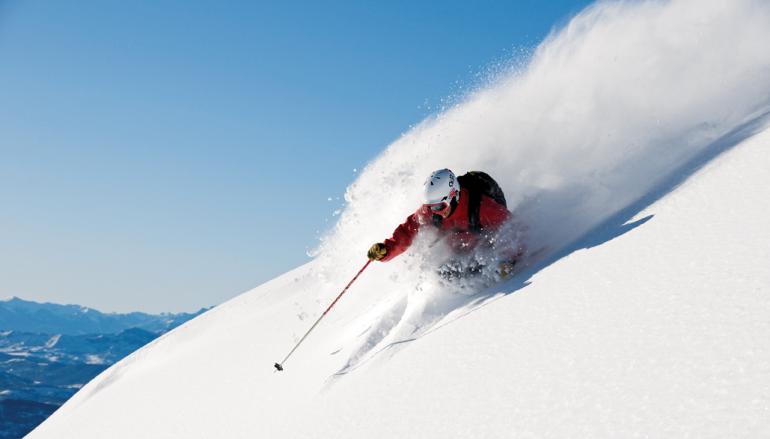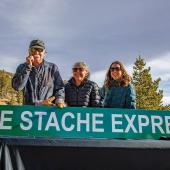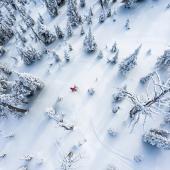The Greatest Chairlift. Ever.
Bridger's bounty opens for business.
What's the most important factor in determining the greatness of a chairlift? The terrain it serves. In one bold move, Bridger Bowl stepped into the big leagues by building a lift that brings skiers a few steps from the top of the Ridge and directly into some of the best ski terrain anywhere. The new Slushman's lift quadrupled the fun factor for expert skiers, and just might be one of the greatest chairlifts ever.
The Changing Face of Bridger Bowl
For many years, this terrain was the ultimate powder stash just outside the ropes of the ski area; the only "legal" access was to skin or hike from the parking lot. There was always a clan of hard-core skiers willing to earn their turns that way. No doubt, some are a little bummed to see the lift to the top of their once private powder stash (see "Paradise Lost"). But the reality is, if you really feel the need to earn your turns, just ride the lift and start walking. The Bridger Range extends both north and south of Bridger Bowl for miles and miles—the possibilities are endless.

The goods.
This lift serves expert terrain only. There is no cat-track or easy way down, and skier traffic is further limited by the rule requiring skiers to carry a transceiver. Very few ski areas have this much steep, technical ski terrain under one lift. The area is littered with unmarked obstacles-cliffs, rocks, and chutes. And if that's not enough, the ski-area boundaries have also been opened. Finally, the backcountry access gates are where they belong... at the top. Simply put, the access is now unbelievable.
For the record, Saddle Peak is not part of Bridger Bowl's ski area. However, you'd never guess that when you see all the tracks up there on a powder day, which is a bit of a sticky point for the Bridger patrollers and managers. Remember, tracks do not necessarily mean a slope is "safe." In fact, everyone watched nervously last season fearing The Big One was about to happen on Saddle Peak. Luckily, no major fractures or slides occurred. However, the potential for a large slide is real, and the cliffs that line the lower slope are massive. This peak demands respect. Just look at it from the highway sometime.
Raising the Bar
All this access also comes with an enormous personal responsibility. The terrain just outside the marked ski area is not controlled for avalanches or patrolled for rescues. Translation: you are on your own—which means you better know where you're going and know what to do if things go awry. Avalanches and injuries happen. Your best hope for rescue—really your only hope—is your ski partner.
When I first started skiing Bridger and hiking the Ridge, there was an unwritten code among locals. It was passed down from the veterans to the rookies from season to season. You didn't hike before the lower mountain was tracked out. You watched for people below you and didn't drop in on them. You skied with your partner, and if you didn't know the way, you went with someone who did. Nowadays it's a free-for-all. None of these basic rules seem to apply. What happened to showing the new guys the ropes? What happened to admitting that you're one of the new guys? What happened to the respect?
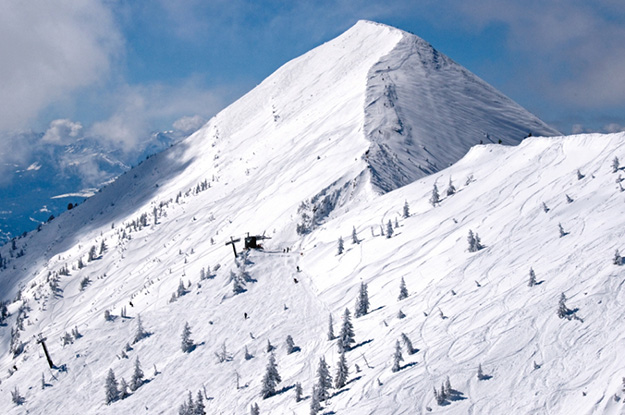
Slushman's bounty.
It seems that everyone who frequented the new Slushman's area last season witnessed clueless people completely disrespecting these tried-and-true rules on Saddle Peak. This large peak lies just south of the new lift and is one of the biggest, most exposed slide paths in the Bridgers. Yet, people were traversing out into the middle of it, dropping off the summit simultaneously, and basically skiing on top of each other. Not good. Perhaps the worst offender I witnessed was a guy on top of Saddle Peak, alone, and drinking a beer. He finished the beer then turned to us and said, "Can I just drop in here, it's pretty straightforward right?"
The Avalanche Center and Bridger Bowl have done an excellent job of getting the word out in an attempt to educate the masses, but evidently it's not enough. There seems to be a misconception that if you're carrying a transceiver, then you're safe in the mountains. Skills and experience must be acquired as well. There are certain times and places to ski relatively safely in the backcountry; and then some days you just shouldn't go. There are also standard practices that always apply in backcountry terrain: know your route, ski one-at-a-time, ski with a partner you trust, and practice using your rescue gear, just to name a few.
Over the past few seasons, Bridger Bowl has come a long way toward true freedom and lift access to the public lands surrounding the ski area. But if local skiers want Bridger to change the current policy of opening Slushman's the day after major storms, we need to show we can handle the responsibility that comes with it. We need to be a community of skiers who understand and educate our fellow powderhounds in the nuances of our beloved pastime. And let's pass the word on and pull together to ensure years of safe shredding on the greatest chairlift ever.
Travis Andersen is a ski photographer and Bridger Bowl Association member. He first skied Bridger Bowl 28 years ago, in 1989. To get involved, join the Bridger Association at bridgerbowl.com and let your ideas be heard by those in charge. Visit mtavalanche.com to learn more about safe practices, current conditions, and where to take an avalanche class.

